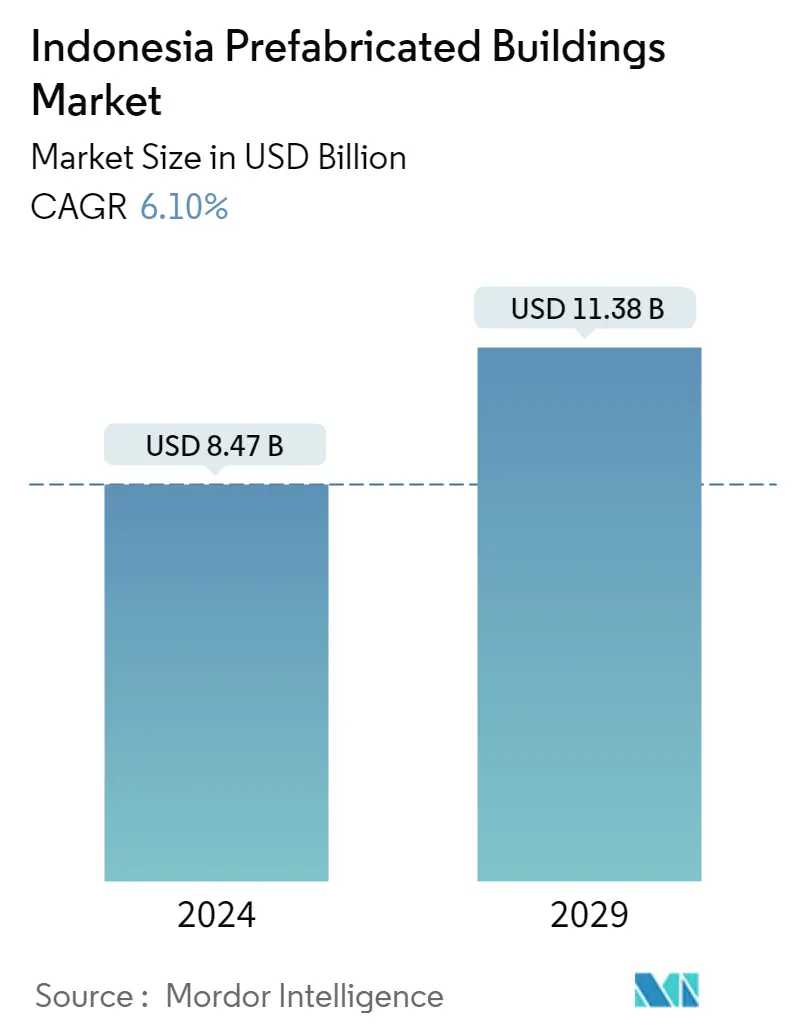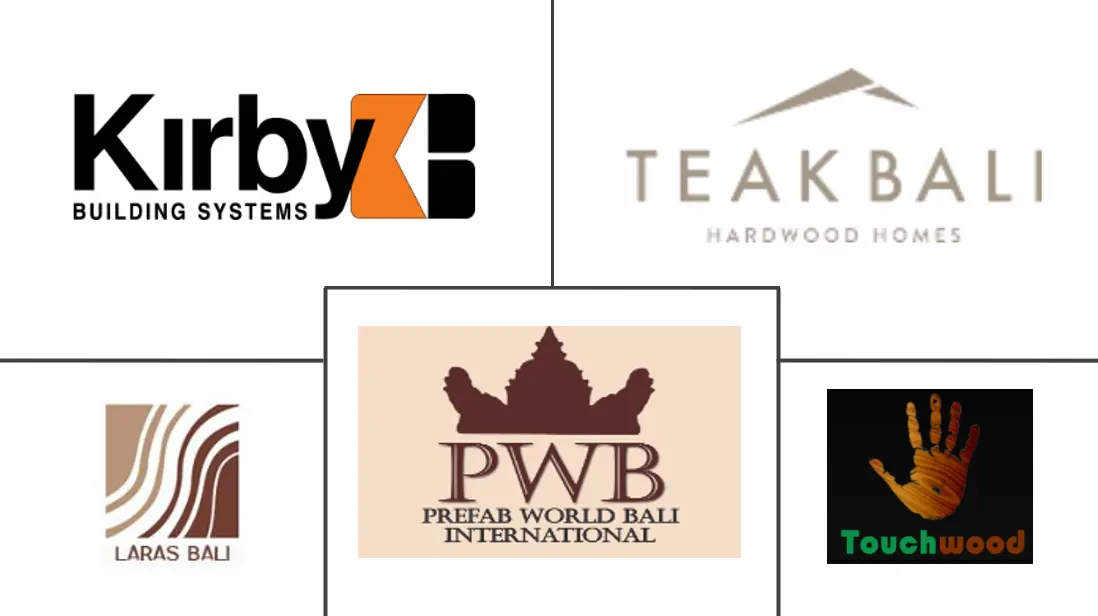Market Size of Indonesia Prefabricated Buildings Industry

| Study Period | 2020 - 2029 |
| Base Year For Estimation | 2023 |
| Market Size (2024) | USD 8.47 Billion |
| Market Size (2029) | USD 11.38 Billion |
| CAGR (2024 - 2029) | 6.10 % |
| Market Concentration | High |
Major Players
*Disclaimer: Major Players sorted in no particular order |
Indonesia Prefabricated Buildings Market Analysis
The Indonesia Prefabricated Buildings Market size is estimated at USD 8.47 billion in 2024, and is expected to reach USD 11.38 billion by 2029, growing at a CAGR of 6.10% during the forecast period (2024-2029).
- The COVID-19 pandemic had a significant impact on the construction sector in Indonesia. Many projects were halted in 2020 due to a lack of funding, labor shortages, and lockdown laws. An exodus of migrant laborers, often known as informal sector employees, wreaked havoc on the supply chain due to travel prohibitions.
- However, due to the medical emergency during the peak of the pandemic in 2020, the demand for prefabricated hospitals and patient bed facilities soared, which boosted the demand for modular building systems, as these types of construction take much less time to complete.
- The demand for low-to-mid-rise residential buildings, project homes, and public housing mainly drives the market's growth.
- Prefabricated construction systems are becoming more popular than traditional ones due to their many advantages, including excellent quality, high strength, low weight, volume, and cost. Prefabricated building systems are frequently praised for their energy efficiency and eco-friendly construction.
- The growing commercial and residential sectors worldwide are driving the demand for ventilated thermal panels, which is the primary growth driver of the prefabricated buildings market.
Indonesia Prefabricated Buildings Industry Segmentation
Prefabricated buildings, or prefabs, are buildings with components (walls, roof, and floor) that are manufactured in a factory or manufacturing plant. These components can be fully or partially assembled in a factory, and are then transferred to the construction site.
The Indonesian prefabricated buildings market is segmented by material type (concrete, glass, metal, timber, and other material types) and application (residential, commercial, and other applications [infrastructure and industrial]). The report offers the market size and forecasts in value (USD million) for the above segments.
| Material Type | |
| Concrete | |
| Glass | |
| Metal | |
| Timber | |
| Other Material Types |
| Application | |
| Residential | |
| Commercial | |
| Other Applications (Industrial, Institutional, and Infrastructure) |
Indonesia Prefabricated Buildings Market Size Summary
The Indonesian prefabricated buildings market is experiencing a notable expansion, driven by the increasing demand for efficient and cost-effective construction solutions. The market is characterized by a shift from traditional construction methods to prefabricated systems, which offer advantages such as enhanced quality, strength, and energy efficiency. The COVID-19 pandemic initially disrupted the construction sector, but it also spurred demand for modular building systems, particularly for healthcare facilities. The growing need for low-to-mid-rise residential buildings and public housing is a significant factor propelling market growth. The commercial and residential sectors' expansion further fuels the demand for prefabricated construction, with ventilated thermal panels being a key growth driver.
Precast concrete holds a dominant position in the market, supported by increased off-site construction activities and government-led infrastructure advancements. The adoption of precast concrete is rising due to its benefits over traditional cast-in-place methods, and awareness among stakeholders is contributing to its broader acceptance. The market is fragmented, with several players like Kirby Building Systems and PT Touchwood, among others, competing for market share. Recent developments, such as the introduction of earthquake-safe precast elements and the establishment of a new data center with modular design, highlight the ongoing innovation and investment in the sector. These trends indicate a robust growth trajectory for the prefabricated buildings market in Indonesia over the forecast period.
Indonesia Prefabricated Buildings Market Size - Table of Contents
-
1. MARKET INSIGHTS
-
1.1 Current Market Scenario
-
1.2 Technological Trends
-
1.3 Insights into Supply Chain/Value Chain Analysis of the Prefabricated Buildings Industry
-
1.4 Brief on Different Structures Used in the Prefabricated Buildings Industry
-
1.5 Cost Structure Analysis of the Prefabricated Buildings Industry
-
1.6 Impact of COVID-19 on the Market
-
-
2. MARKET SEGMENTATION (Market Size be Value)
-
2.1 Material Type
-
2.1.1 Concrete
-
2.1.2 Glass
-
2.1.3 Metal
-
2.1.4 Timber
-
2.1.5 Other Material Types
-
-
2.2 Application
-
2.2.1 Residential
-
2.2.2 Commercial
-
2.2.3 Other Applications (Industrial, Institutional, and Infrastructure)
-
-
Indonesia Prefabricated Buildings Market Size FAQs
How big is the Indonesia Prefabricated Buildings Market?
The Indonesia Prefabricated Buildings Market size is expected to reach USD 8.47 billion in 2024 and grow at a CAGR of 6.10% to reach USD 11.38 billion by 2029.
What is the current Indonesia Prefabricated Buildings Market size?
In 2024, the Indonesia Prefabricated Buildings Market size is expected to reach USD 8.47 billion.

